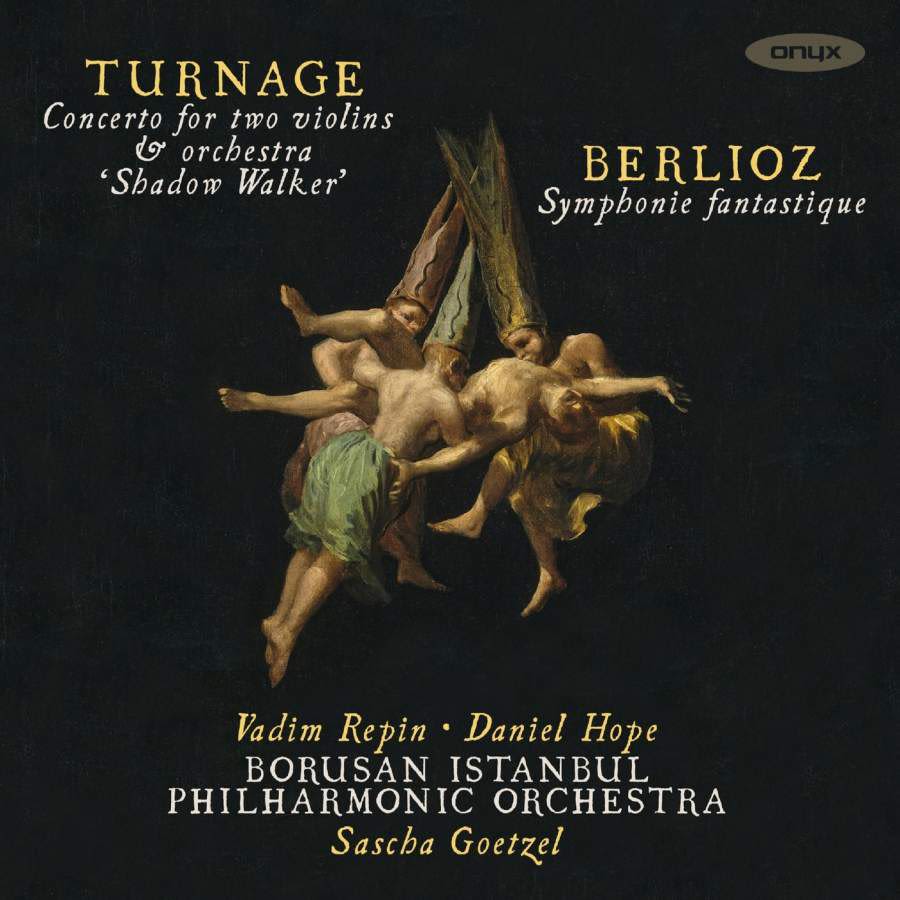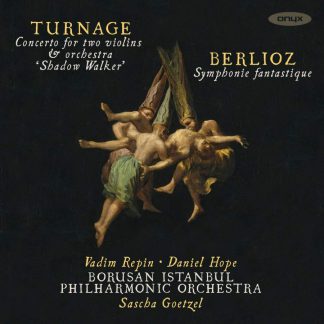Περιγραφή
Καλλιτέχνες
|
Turnage – Shadow Walker Mark-Anthony Turnage’s new double violin concerto, Shadow Walker, was premiered by soloists Vadim Repin and Daniel Hope in Istanbul on 19 October 2017 with the Borusan Istanbul Philharmonic Orchestra under Sascha Goetzel. The new 25-minute work is dedicated to artist Mark Wallinger, whom Turnage collaborated with on his ballets Trespass and Undance. The title Shadow Walker is drawn from a Wallinger video in which the artist lms his shadow as he walks along Shaftesbury Avenue in London, exploring themes of identity and replicated imaging. The disembodied shadow takes on its own life in relation to the public on the streets, allowing the artist to experience the city as a aneur behind a mask of anonymity. Turnage’s work also references Wallinger’s series of ‘id paintings’, life-size action art images whose bilateral symmetry resembles the two halves of the human body. Mark-Anthony Turnage describes how ‘I’ve been drawn to compose double concertos before, such as Dispelling the Fears for two trumpets, and in Shadow Walker I’ve again been intrigued by the possibilities of interplay between the two soloists. The idea of shadowing can take many musical forms, such as through canonic writing and the imitation of intervals, though I haven’t gone as far as composing a fugue. The string sound of Vadim Repin and Daniel Hope should blend particularly well, almost like two aspects of the same identity. There isn’t a strict hierarchical relationship with one violin the shadow of the other – it is much more equal and uid. ‘The obvious model is the Bach Double Violin Concerto, which I love, but I don’t see the new work as neo- classical and haven’t tried to pastiche a baroque style. My passion for Bach is more to do with the technical aspect, something pure in his music which transcends style. My orchestration is quite distant from Bach, unusually coloured with some Turkish percussion instruments including kas ̧ık, davul and bass darbuka, re ecting the Istanbul orchestra premiering the work.’ Shadow Walker is cast in four movements, Fast-Slow-Fast-Slow, with the third movement taking the form of a scherzo. A wide range of contrapuntal techniques are employed by Turnage, from general imitation and echo, to strict canon – such as the opening of the fourth movement starting with the two soloists in turn and proliferating through the strings to build a rhythmically and harmonically complex texture. Mirror canon also appears, which is more closely related to the symmetrical techniques in Wallinger’s ‘id paintings’. Berlioz – Symphonie fantastique op.14 In September 1827, Hector Berlioz went to a performance of Hamlet at The Odéon-Théâtre in Paris. There in a coup de foudre he fell in love with the English Irish-born actress playing Ophelia. Her name was Harriet Smithson. All his attempts to meet or contact her met with no success. Berlioz even rented an apartment from where he could see her return home and watch until she went to sleep. From this letter to his father, written in February 1830, we get a vivid glimpse of Berlioz’s impetuous, excessive and passionate state of mind: ‘I wish I could … calm the feverish excitement which so often torments me; but I shall never nd it, it comes from the way I am made. In addition, the habit I have got into of constantly observing myself means that no sensation escapes me, and re ection doubles it – I see myself in a mirror.’ Over the three years following that memorable Hamlet, Berlioz wrote the work that has come to de ne him, the rst real symphony of the Romantic period, a musical autobiography and gigantic love letter written for the object of his affections. The Symphonie fantastique received its rst performance at the Paris Conservatoire on 5 December 1830, a date Berlioz timed to coincide with the return to Paris of his grande passion. ‘Alas!’ wrote Berlioz, ‘I learned afterwards that, absorbed in her own brilliant career, she never even heard of my name, my struggles, my concert, or my success!’ In the audience, however, were Meyerbeer, Spontini and the 19-year-old Franz Liszt whom Berlioz had met for the rst time the day before. Afterwards, Berlioz recorded, ‘[Liszt] literally dragged me off to have dinner at his house and overwhelmed me with the vigour of his enthusiasm’. An anonymous reviewer wrote of the premiere: ‘I accept that this symphony is of an almost inconceivable strangeness… But for anyone who isn’t too concerned about the rules I believe that M. Berlioz, if he carries on in the way he has begun, will one day be worthy to take his place beside Beethoven.’ Two years later, having discovered that Harriet was back in Paris, Berlioz arranged for a second performance of the Symphonie fantastique. This time, the bewildered actress came, heard and was conquered. He knew no English and she knew no French, but after a feverish courtship in which they became lovers and Berlioz made a feeble attempt at suicide to prove the intensity of his feelings for her, they married in October 1833. Predictably, perhaps, the marriage was not a success. They separated a decade later. The Symphony, subtitled ‘An Episode in the Life of an Artist’, is in ve movements. A young musician of unhealthy and sensitive nature is haunted by a woman’s face. His Beloved takes the form of a musical phrase, like an earworm. He sees her everywhere until at last, despairing of ever gaining her love, he poisons himself with opium – not enough to kill him but enough to give him horrible visions. It was no coincidence that in 1828 Alfred de Musset had published his version of Thomas de Quincey’s Confessions of an English Opium-Eater (1821). There is little doubt that Berlioz was taking opium throughout 1829 and 1830.
Jeremy Nicholas 2018 |










